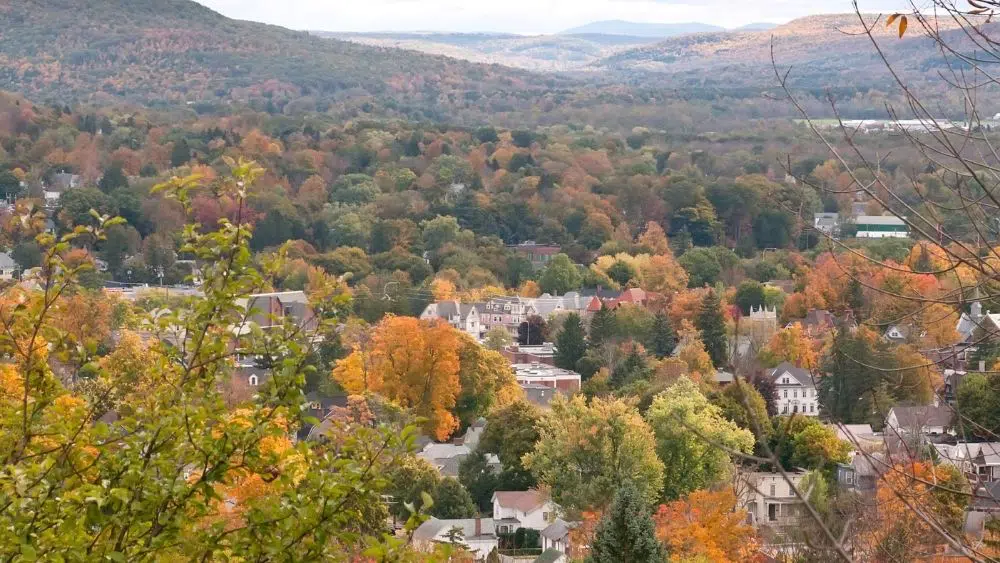
New York City, the city of dreams… and one of the most notoriously expensive cities to live in. As this list is sorted by lowest price-to-income ratio, you won’t see The Big Apple make an appearance (sorry!). However, there are plenty of quaint and large towns in New York for those who want to live in the northeastern U.S. Rich history, amazing architecture, nature, scrumptious eats and all four seasons can be experienced in cities like Rochester and Buffalo. Widen your horizons by reading more about the 10 ten best places to live in The Empire State.
1. Elmira
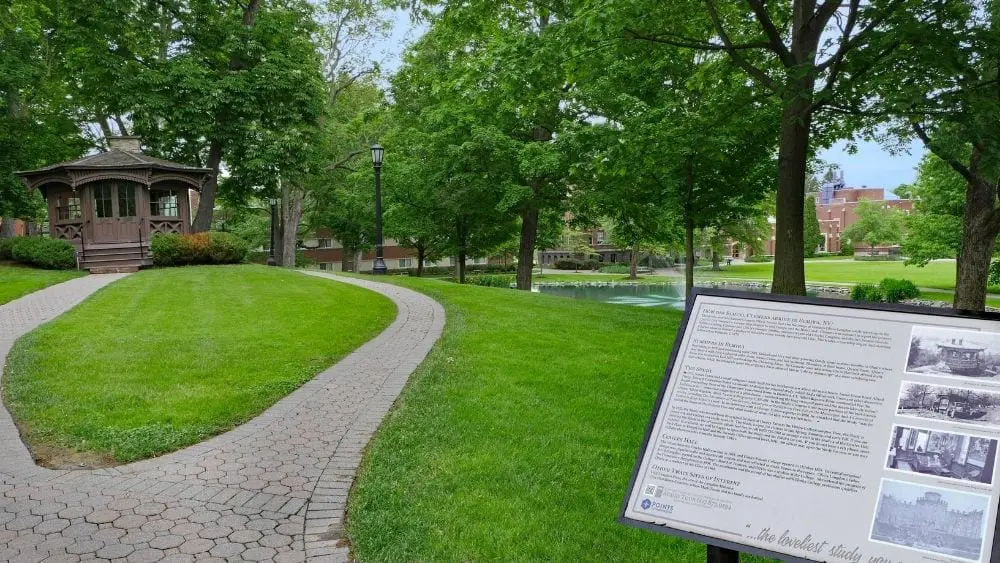
Housing cost to income ratio: 1.21
Average childcare cost to income ratio: 1.39%
Violent crime index: 16.6
Nonviolent crime index: 48.5
Cost of living index: 74.6
Live in a small tight-knit community. Elmira, New York is nestled in the picturesque Finger Lakes region, offers a unique blend of small-town charm, historical significance, and natural beauty. This excellent location is ideal for new homebuyers with a growing downtown area. Find yourself two hours from cities like Rochester, Syracuse, Ithaca, and Binghamton.
One of the biggest draws of Elmira is its low cost of living. It also recognizes the importance of its youth with a substantial spending per student ratio in both elementary and secondary public schools. Elmira High School is known for its strong academic programs. Private options like Elmira Christian Academy are great alternatives. Elmira College, a private liberal arts college, is also notable for its degree options.
The city is packed with interesting sights to visit like the Arnot Art Museum, Chemung Valley History Museum (a treasure of local history), and Eldridge Park. Mark Twain wrote his most significant work – including the Adventures of Huckleberry Finn – while summering in Elmira. In 1952, his work was preserved and is now on exhibit at Elmira College.
Get out to enjoy the Finger Lakes area with hiking and biking trails, fishing and boating. The Lackawanna Rail Trail is a popular spot for walking and cycling. Nearby state parks like Watkins Glen State Park and Harris Hill Park offer stunning natural landscapes, hiking trails, and camping facilities. Eldridge Park, with its historic carousel, is a family favorite within Elmira. Your furry friends can get in on the action at Elmira Dog Park and the Tanglewood Nature Center and Museum with over 10 miles of trails.
A strong sense of community is felt at local events including the Elmira Street Painting Festival and the popular Elmira Jazz Festival, showcasing local and regional talent. Elmira is known as “Mark Twain Country,” as the famous author spent many summers here and is buried in Woodlawn Cemetery.
Arnot Ogden Medical Center and St. Joseph’s Hospital in Elmira provide comprehensive healthcare services to the community. Key employers in and around Elmira offer a variety of career paths in manufacturing, education, and healthcare. Hilliard Corporation, the Arnot Health system, and Elmira College are some of the largest employers.
Elmira is an excellent New York home location. Find your perfect fit in this beautiful part of the state. Southern New York is sure to check off your wants and needs list.
2. Jamestown
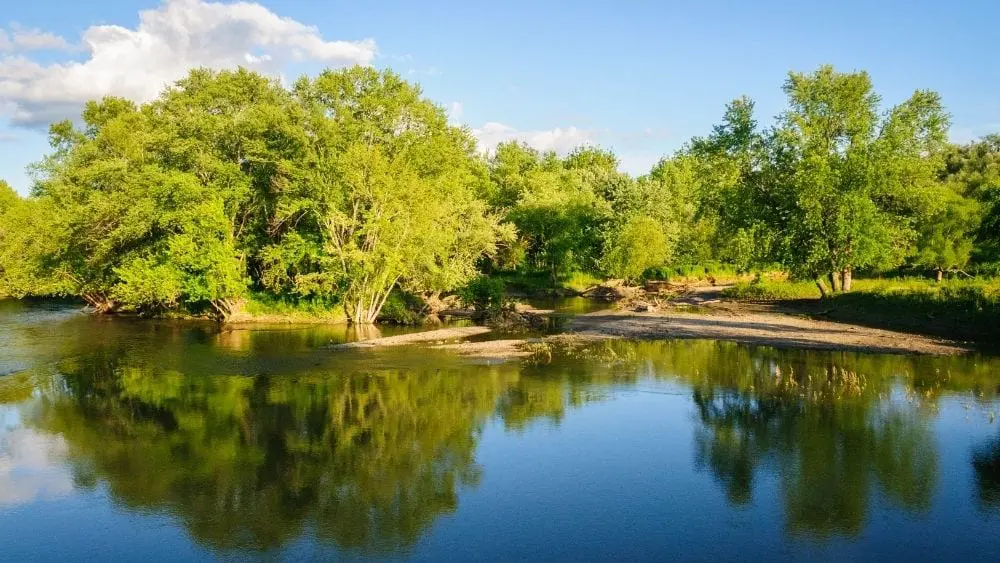
Housing cost to income ratio: 2.61
Average childcare cost to income ratio: 2.77%
Violent crime index: 45.5
Nonviolent crime index: 57.6
Cost of living index: 78.4
Growing tired of the city grind? Enjoy a slower pace of life in Jamestown, nestled on the southern end of beautiful Chautauqua Lake. The population here is even smaller than Elmira, just over 20,000 residents. Jamestown is the birthplace of Lucille Ball, ‘The First Lady of Comedy’, and fittingly, there is a museum dedicated to her. Fans of comedy will also enjoy visiting the National Comedy Center, which offers immersive comedic experiences tailored to your preferences based on a ‘humor profile’ that visitors create. The Lucille Ball Comedy Festival attracts visitors from all over the country.
Jamestown has a strong public school system and offers endless opportunities for students to reach their higher education goals. You can commute across town in about 10 minutes. Plus, the downtown area is turning around as new coffee shops, bars, restaurants, and activities are constantly popping up.
Jamestown experiences a typical Northeastern climate. Winters can be quite snowy and cold, owing to their proximity to the Great Lakes, while summers are generally warm and pleasant. Spring and autumn are mild and showcase the area’s natural beauty. The city is near Chautauqua Lake, which provides opportunities for boating, fishing, and swimming. On land, there are numerous hiking and biking trails. In winter, the area becomes a destination for snow sports like skiing and snowboarding. Nearby, the Allegany State Park offers stunning landscapes for camping, hiking, and wildlife viewing. Within the city, there are several parks, like Bergman Park, ideal for family outings and picnics.
Find the healthcare services you need at UPMC Chautauqua. Major employers are found in the manufacturing, healthcare, and education fields with Cummins Engine Plant, UPMC Chautauqua hospital, and Bush Industries leading the way. A focus on growing and revitalizing the downtown area is promoting business and tourism.
Live in the Western New York region in the “Furniture Capital of the World.” Jamestown offers the spirit of a welcoming community with its balanced and fulfilling lifestyle.
3. Rochester
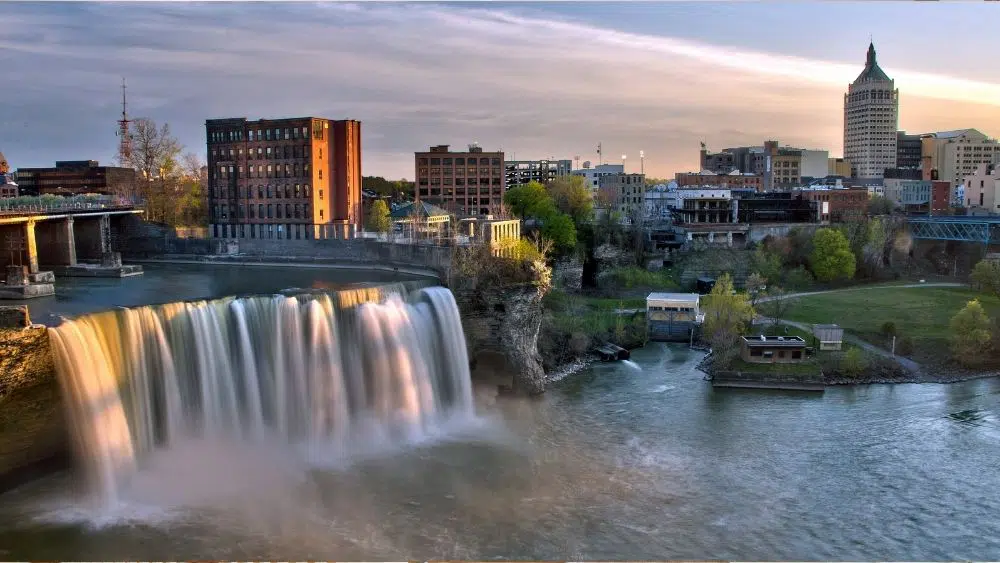
Housing cost to income ratio: 3.07
Average childcare cost to income ratio: 3.14%
Violent crime index: 45.5
Nonviolent crime index: 57.6
Cost of living index: 78.4
Which city is close to lakes, parks, beaches, has a thriving art community, world-class healthcare, and a low cost of living? Look no further than Rochester, a diverse, liberal city of around 200,000 which rests alongside Lake Ontario. The most popular suburbs to live in are Honeoye Falls, Churchville, and Spencerport. Rochester is known as the “Flower City” due to its numerous parks and gardens. It was also the birthplace of Kodak, making it a historic center for photography and film. The city played a significant role in the women’s suffrage movement, with Susan B. Anthony being a notable resident.
Opportunities for pursuing higher education are abundant here with the University of Rochester, St. John Fisher College, and the Rochester Institute of Technology all at the community’s disposal. The public schools throughout Monroe County are similarly top-rated. The area is served by multiple public-school districts, including the Rochester City School District, which offers a variety of educational programs and extracurricular activities. There are also several prestigious private schools, such as The Harley School and Allendale Columbia School, known for their rigorous academics. Rochesterians can enjoy world-class healthcare through UR Medicine. The city is served by top-notch medical facilities, including Strong Memorial Hospital, part of the University of Rochester Medical Center, and Rochester General Hospital.
Additionally, Rochester boasts a thriving arts community, hosting annual events like the Jazz Festival and Corn Hill Arts Festival. The city’s transportation system is relatively easy to navigate, although the suburbs are almost unreachable without a vehicle. Above all, this charming city in western New York is an excellent place to build a comfortable and affordable home, while taking advantage of all the major resources it offers.
The city’s proximity to the Great Lakes and the Genesee River provides numerous opportunities for water-related activities, including boating, fishing, and kayaking. Rochester also boasts extensive parks and trail systems for hiking, cycling, and winter sports. Nearby parks include Highland Park, famous for its annual Lilac Festival, and Genesee Valley Park. Letchworth State Park, known as the “Grand Canyon of the East,” is a short drive away and offers stunning views, hiking trails, and waterfalls. Rochester is home to several dog parks, such as Ellison Dog Park and Greece Canal Dog Park, where pets can play off-leash.
Rochester is rich in culture and history. The Strong National Museum of Play, the George Eastman Museum, and the Rochester Museum & Science Center offer diverse experiences. The city is also known for its vibrant arts scene, including theaters like the Eastman Theatre and the Rochester Auditorium Theatre. The Rochester Lilac Festival and the Park Avenue Summer Art Festival draw locals and visitors annually.
The economy is diverse, with significant sectors in healthcare, education, and technology. Major employers include the University of Rochester and its affiliated UR Medicine, Wegmans Food Markets, and Xerox. The city is also a hub for innovation and startups.
Overall, Rochester’s combination of cultural richness, educational opportunities, and natural beauty make it an attractive location for new homebuyers seeking a dynamic yet affordable place to live.
4. Utica-Rome
Housing cost to income ratio: 5.11
Average childcare cost to income ratio: 1.93%
Violent crime index: 22.8
Nonviolent crime index: 46.3
Cost of living index: 71.3
Utica and Rome are in Oneida County and are separated by about a 20-minute drive. Both of these principal cities in central New York lean conservative. Utica is a larger city with about 60,000 residents while Rome is home to around 32,000.
Utica is known for its unique cuisine, including dishes like “chicken riggies” and “Utica greens.” Enjoy the delicious tasty ethnic restaurants throughout Utica. Rome holds historical significance as the site for the construction of the Erie Canal, which played a crucial role in the early development of the United States. The city has a rich history as it was once a textile hub in the 19th century. “Rome is home” rings true as Rome has a strong sense of community. Small, family-owned businesses are strongly supported, and neighbors check in on one another. Although Rome may not have a large nightlife scene, it does offer an exciting downtown arts district.
Outdoor activities are abundant in the Utica-Rome area. The region is near the Adirondack Mountains, offering hiking, camping, and skiing opportunities. The Mohawk River and nearby lakes provide settings for fishing, boating, and water sports. State parks like Delta Lake State Park and Pixley Falls State Park offer natural beauty and outdoor recreation. The Erie Canal Trail also provides a unique historical and recreational experience for hiking and biking.
The area is rich in cultural attractions, including the Munson-Williams-Proctor Arts Institute in Utica and the Rome Historical Society & Museum. These institutions offer insights into the region’s history and cultural heritage. Utica-Rome hosts several festivals, including the popular Boilermaker Road Race in Utica and the Honor America Days festival in Rome, showcasing the area’s community spirit and cultural diversity.
The area is served by various school districts and private schools. Offering a range of educational programs with caring staff are Utica City School District and Rome City School District. The area is home to institutions like Utica College and Mohawk Valley Community College for higher education. Major medical facilities in the area include St. Elizabeth Medical Center in Utica and Rome Memorial Hospital, providing comprehensive healthcare services to residents. Some of these local educational institutions along with Rome Memorial Hospital, ConMed Corporation and an abundance of small businesses boost the economy and provide a wide array of job opportunities.
Ultimately, it is a wonderful place to put down some roots. Utica-Rome, nestled in the heart of New York State, offers a unique blend of historical charm, natural beauty, and a strong sense of community, making it an appealing choice for new homebuyers. The area presents an intriguing setting for those seeking a peaceful yet engaging lifestyle in Central New York.
5. Buffalo-Niagara Falls
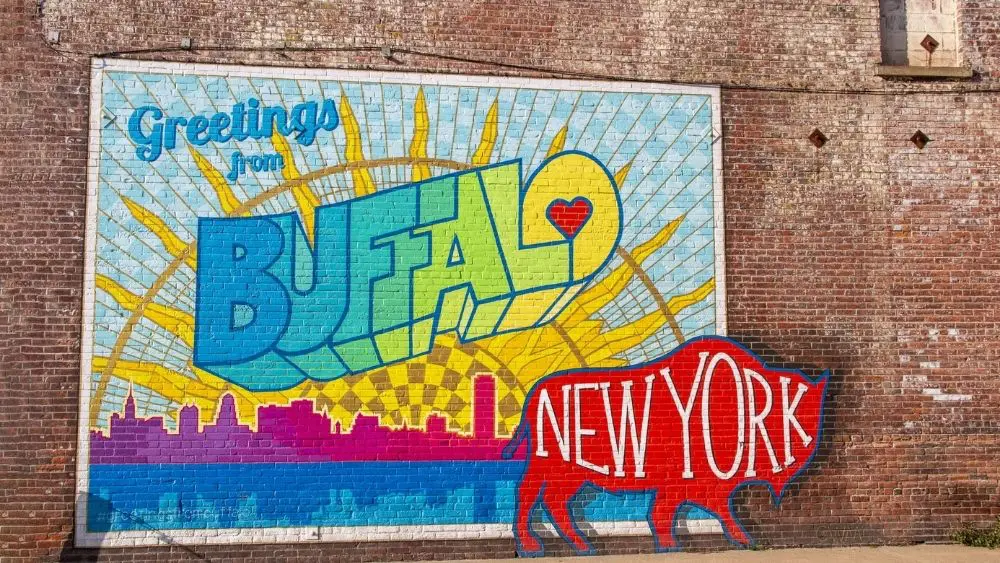
Housing cost to income ratio: 2.36
Average childcare cost to income ratio: 1.05%
Violent crime index: 16.7
Nonviolent crime index: 29.2
Cost of living index: 94.1
The beauty and friendly demeanor of the Buffalo-Niagara Falls area is hard to resist. The Buffalo-Niagara Falls area in New York, known for its iconic natural wonders, rich history, and cultural vibrancy, presents an enticing opportunity for new homebuyers. This region offers a unique mix of urban living, natural beauty, and a friendly community atmosphere.
From fantastic food to the craziest football fan base in the NFL, Buffalo is a beloved “city of good neighbors.” Buffalo is home to about 255,000 residents and the top places to live are Orchard Park, Hamburg, and Williamsville. The famed Niagara Falls are just a 20-minute drive north of Buffalo. The falls are beautiful in all seasons and a must-see when frozen. The city has around 48,000 residents and has a relatively low crime rate.
Buffalo is like Cleveland and Pittsburgh, but with a lower cost of living. The city has wintry weather (about 85 inches of snow per year) but locals are accustomed to and well-equipped for snowstorms. In contrast, summertime is lovely in the city, with average highs of about 80 degrees. You can rent a kayak on Canalside or enjoy a stroll through Broderick Park. Filled with stunning architecture; Buffalo has many notable buildings constructed between the American Civil War and the Great Depression. In addition to public landmarks, there are several Frank Lloyd Wright projects and residential homes like Delaware Avenue’s Millionaire’s Row.
Niagara Falls offers unique recreational opportunities, including boat tours and scenic walks. Don’t miss a Maid of the Mist boat ride feeling the powerful spray of the falls. Niagara Falls is one of the most famous natural attractions in the United States, drawing millions of visitors yearly. The region is also known for its extensive park system, including the Buffalo and Erie County Botanical Gardens and Delaware Park. From Knox Farm State Park to Ellicott Island Bark Park as well as Letchworth State Park there are many places to play and connect with nature.
The region boasts significant cultural attractions, including the Albright-Knox Art Gallery and the Buffalo Museum of Science. The area’s rich history is showcased at the Buffalo History Museum and the Old Fort Niagara. The Buffalo-Niagara Falls area hosts several festivals, including the Buffalo Cherry Blossom Festival and the Lewiston Jazz Festival, celebrating the area’s cultural and artistic diversity. The area hosts various community events throughout the year, such as the National Buffalo Wing Festival and outdoor concerts.
The area is served by multiple school districts, notably Buffalo Public Schools and Niagara Falls City School District. Enroll in higher education courses at the University at Buffalo and Niagara University. Key hospitals in the area include Buffalo General Medical Center and Niagara Falls Memorial Medical Center. Strengthening the economy are major employers like the University at Buffalo, Kaleida Health, and M&T Bank.
The Buffalo-Niagara Falls area offers a rich blend of natural beauty, historical significance, and urban amenities. This combination, along with a welcoming community, a range of recreational and cultural activities, and a robust educational system, makes it an attractive location for new homebuyers seeking a dynamic and fulfilling lifestyle in Western New York.
6. Binghamton
Housing cost to income ratio: 3.35
Average childcare cost to income ratio: 2.67%
Violent crime index: 36.6
Nonviolent crime index: 62.7
Cost of living index: 74.5
Binghamton is a wonderful place to raise children, as there are diverse schools within a thriving community. The city of around 45,000 is known as the ‘Carousel Capital of the World’ as it is home to vintage hand-carved carousels. Home to six of the remaining antique carousels gifted by George F. Johnson, the public enjoys these amenities for free. In addition, there are many other attractions such as Ross Park Zoo, the Phelps Mansion Museum, the Bundy Museum of History and Art, and First Friday Art Walks which take place rain or shine. Binghamton, New York, often referred to as the “Parlor City,” offers a unique blend of urban and natural attractions, making it an appealing choice for new homebuyers.
This welcoming city has a strong economy. Major players are found in the fields of education, healthcare, and the high-tech industry. Key employers include Binghamton University, UHS, and Lockheed Martin as well as many small businesses and startups.
There are ample services and amenities in Binghamton. The Binghamton City School District serves the area, with notable schools like Binghamton High School, known for its diverse programs. There are also private options such as The Susquehanna Valley School District, offering different educational approaches. Healthcare facilities like United Health Services (UHS) Hospitals and Lourdes Hospital provide comprehensive medical services to residents. It’s an easy commute to New York City, Philadelphia, and Buffalo. Those looking to pursue higher education will be delighted to know Binghamton University is a State University of New York (SUNY) school which offers undergraduate, master’s, and doctoral degrees.
The city is known for its verdant landscapes and scenic beauty, which are perfect for outdoor activities. The Chenango and Susquehanna Rivers provide opportunities for fishing and kayaking. The city also hosts numerous community events, including First Friday Art Walks, and the July Fest and Jazz Festival. The Spiedie Fest and Balloon Rally celebrates a local culinary specialty, and the Broome County Fair showcases the area’s agricultural heritage.
Roberson Museum and Science Center features a planetarium and diverse exhibits. The Phelps Mansion Museum and The Discovery Center of the Southern Tier offer insights into local history and interactive experiences for children. Nearby, Chenango Valley State Park offers a beach, golf course, and trails for hiking and cross-country skiing. Otsiningo Park is a local favorite for its walking paths, playgrounds, and sports fields. Dog-friendly spots include Cheri A. Lindsey Memorial Park and Dog Park.
The choice of Binghamton is a good one. It makes our list for its friendly demeanor, beauty, and amenities. Settling in this area in a new home would be a perfect place for families, young professionals, and retirees.
7. Glens Falls
Housing cost to income ratio: 2.61
Average childcare cost to income ratio: 2.10%
Violent crime index: 11.1
Nonviolent crime index: 28.6
Cost of living index: 87.3
Big enough to not be humdrum yet small enough for that small-town feel, Glens Falls is a walkable city of approximately 14,300. It’s about a three-hour drive north of New York City. For a city of its size, there are ample resources, recreation, and amenities. It has the nickname of the ‘Arts & Entertainment Gateway to the Adirondacks.’
Glen Falls has the healthcare, schools, and economy you desire in a great location. Over the years, Glens Falls has become more developed. Major employers include Glens Falls Hospital, Finch Paper, and AngioDynamics. The city also supports small businesses and startups, contributing to a robust local economy. The city is served by the Glens Falls City School District, which includes Glens Falls High School, known for its strong academic and athletic programs. There are also private education options available, like St. Mary’s-St. Alphonsus Regional Catholic School, offering an alternative educational environment. Glens Falls Hospital is the main healthcare provider in the area, offering a range of medical services.
Outdoor enthusiasts love the ability to get to lakes, the beach, mountains, and farms. The city is close to the Adirondack Mountains, providing ample opportunities for hiking, camping, and skiing. The Feeder Canal Trail is popular for walking and biking. Spend your free time swimming, hiking, and camping at Moreau Lake State Park. Glen Falls parks provide plenty of spots for leisure and sports. Check out Crandall Park and Cole’s Woods.
Residents come together at fun events throughout the year. The Glens Falls Balloon Festival is a major attraction with its colorful hot air balloons. Glens Falls is known for its vibrant arts scene. Visit the Hyde Collection to see a distinguished collection of European and American art. The Charles R. Wood Theater hosts various cultural events and shows.
Glens Falls is often referred to as “Hometown U.S.A,” a title given by Look Magazine in 1944. The city is also just a short drive from Lake George, a popular tourist destination known for its scenic beauty and recreational activities. A new home in this inviting city will enhance your quality of life.
8. Orange County
Housing cost to income ratio: 4.22
Average childcare cost to income ratio: 1.60%
Violent crime index: 10.5
Nonviolent crime index: 22.9
Cost of living index: 119.7
With a population of about 400,000, Orange County is the largest area on this list; still, residents enjoy a relatively low crime rate and cost of living. The culturally diverse and liberal-leaning area has two top suburbs, Monroe and Highland Falls.
A big plus of living in Orange County is its proximity to nature. Families can explore Bear Mountain, walk the trails of Storm King Mountain, or play in the snow on Mount Peter. Orange County, New York, is a compelling destination for new homebuyers, offering a unique blend of natural beauty, rich history, and a thriving community. The Hudson River provides a backdrop for boating, fishing, and kayaking. Hiking enthusiasts enjoy trails in Bear Mountain State Park and the scenic views of the Hudson Highlands. Notable parks in Orange County include Harriman State Park, one of the largest state parks in New York, offering hiking, camping, and fishing. Sterling Forest State Park is another gem, known for its pristine natural environment.
Orange County is rich in history and culture. The West Point Museum, near the United States Military Academy, offers military history exhibits. The Storm King Art Center is an open-air museum featuring large-scale sculptures and installations. The county is also known for its historic homes and sites, such as Washington’s Headquarters State Historic Site.
The county has a mix of public and private schools. Public schools like Monroe-Woodbury and Cornwall Central School Districts as well as private schools such as The Storm King School and Tuxedo Park School offer specialized curriculums with academic rigor. Key healthcare facilities include Orange Regional Medical Center and St. Luke’s Cornwall Hospital. The economy is supported by healthcare, retail, and manufacturing. The United States Military Academy at West Point, Orange Regional Medical Center, and Touro College of Osteopathic Medicine are some of the larger employers supporting the vibrant economy.
Orange County hosts a variety of festivals throughout the year, such as the New York Renaissance Faire in Tuxedo and the Warwick Applefest, celebrating the county’s apple orchards and local produce. As part of the Hudson Valley, Orange County is known for its wineries and vineyards. The county has a rich history with pivotal Revolutionary War sites. It is just an hour’s drive from New York City, making it attractive for commuters.
Orange County, New York, offers an attractive mix of outdoor recreation, cultural richness, and a strong sense of community, making it an ideal place for new homebuyers seeking a beautiful New York lifestyle.
9. Albany-Saratoga
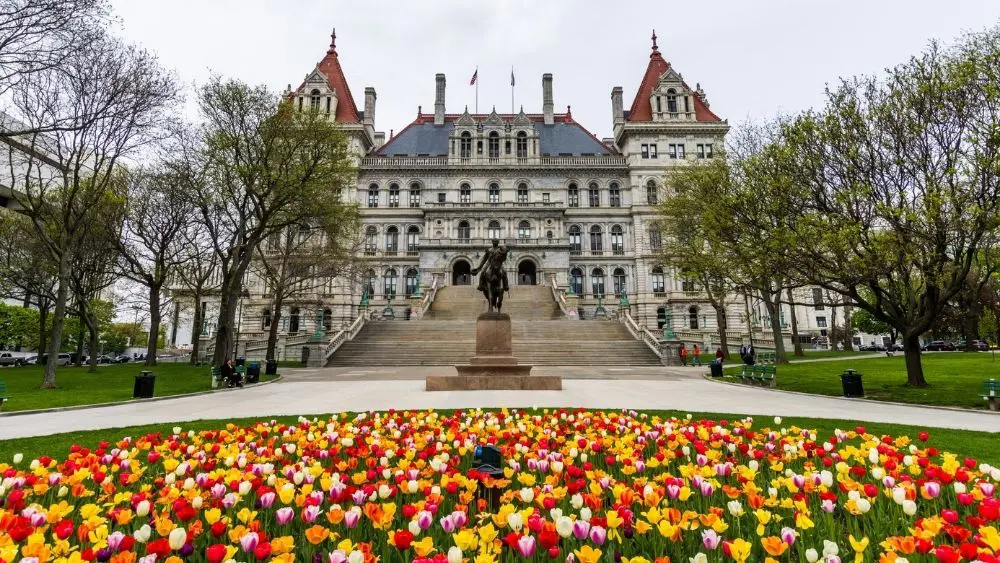
Housing cost to income ratio: 3.87
Average childcare cost to income ratio: 1.73%
Violent crime index: 25.0
Nonviolent crime index: 46.8
Cost of living index: 76.1
Albany, the capital of New York, is a historic city with records tracing more than 400 years ago. Nearly 100,000 residents call Albany home with another 31,000 making its northern neighbor, Saratoga home. Despite Albany’s size, one of its nicknames is ‘Smallbany’, as well as ‘Tech Valley’ since it serves as headquarters to many tech startups.
Job seekers will find many openings for tech, government, and state employment opportunities. Major employers here include the State of New York and Albany Medical Center. As the state capital, Albany is a hub for government and commerce.
Saratoga Springs is known for its arts, culture, and the famous Saratoga Race Course. Saratoga is nicknamed the ‘Hamptons of Upstate’ due to its historic racetrack, which is a hot spot for locals and tourists during the summer. It is a gorgeous little town bordering the Adirondack mountains and the Vermont countryside. The town is full of life, filled with families, young professionals, and retirees.
There is no shortage of activities. You can explore the New York State Museum, embark on a cruise on the Hudson River, and attend a yoga class at Washington Park. Weekend getaways are also easy as you are only a short drive from Montreal, Lake George, Boston, and New York City. From the urban environment of Albany to the more suburban and historic feel of Saratoga Springs, the area offers a variety of living experiences.
The area is close to the Adirondack Mountains, offering outdoor activities like hiking, camping, and skiing. The Saratoga Spa State Park and the Albany Pine Bush Preserve are great for outdoor exploration. Saratoga Springs hosts the annual summer horse racing season, drawing visitors globally. Albany offers various cultural events, including music and food festivals. Enjoy a soak in one of the mineral baths at the Roosevelt Baths & Spa.
The region is served by several public-school districts known for their strong academic programs, including Albany City School District and Saratoga Springs City School District. There are also numerous private schools as well as higher education institutions like the University at Albany and Skidmore College in Saratoga Springs.
The area hosts numerous festivals, including the Saratoga Jazz Festival and Albany’s Tulip Festival, which celebrate the region’s cultural diversity and heritage. The Empire State Plaza is a hub for cultural activities. Be sure to attend one of the many performances and concerts at the Saratoga Performing Arts Center.
Major medical facilities include Albany Medical Center and Saratoga Hospital, providing comprehensive healthcare services to the community. You’ll find a variety of services, restaurants, and shopping to meet all your needs. A new home in this area is appealing to many new homebuyers.
10. Dutchess County
Housing cost to income ratio: 4.11
Average childcare cost to income ratio: 1.68%
Violent crime index: 26.6
Nonviolent crime index: 43.6
Cost of living index: 88.8
With a population of around 300,000, Dutchess County is a highly desirable place to live. The top areas are Spackenkill, Arlington, and Myers Corner, which boast highly rated schools. Dutchess County is surrounded by beautiful lakes and rivers, providing ample boating and fishing opportunities. Summertime weather is warm with average highs of 75 degrees, while Mother Nature delivers about 44 inches of snow annually, so you can enjoy snowmobiling, skiing, and ice skating.
Another draw of Dutchess County is its proximity to attractions and major cities. It is only two hours to the Adirondacks Mountains, an hour to the Catskill Mountains, and two hours to New York City. Dutchess County is one of the 12 original New York counties, meaning there is an abundance of historical places to visit. See the opulence of the Gilded Age at the Vanderbilt Mansion National Historic Site, visit the home of Franklin D. Roosevelt or bike along the Walkway over the Hudson. Hiking trails abound in areas like the Appalachian Trail and Mount Beacon. Fahnestock State Park is ideal for hiking, camping, and winter sports.
The county is rich in history and culture. The Franklin D. Roosevelt Presidential Library and Museum in Hyde Park, the Dia Beacon Art Museum, and the Mid-Hudson Children’s Museum cater to a variety of interests. Dutchess County’s calendar is dotted with festivals. The Dutchess County Fair is one of the largest in New York state, and the Rhinebeck Sheep and Wool Festival celebrates the region’s agricultural heritage.
The area boasts a mix of private and public schools. Public schools like Arlington High School and Millbrook High School are known for their academic and extracurricular programs. Prestigious private institutions, such as The Hotchkiss School and Millbrook School, offer rigorous curriculums and lush campuses. The Culinary Institute of America, located here, is one of the world’s premier culinary schools. The county is served by several hospitals, including Vassar Brothers Medical Center and MidHudson Regional Hospital with experienced staff providing excellent health care.
The economy is robust with sectors like healthcare, education, and manufacturing playing significant roles. Major employers include IBM, Health Quest, and Marist College. The county also has a growing small business and entrepreneurial scene.
Dutchess County is part of the Hudson Valley, known for its wineries and as the birthplace of American wine. New homes here are popular in amenity rich neighborhoods. Enjoy all the perks of a new home in a great location in Dutchess County.
Rakini Bergundy was born in a little surf town called Houhai in China and loves writing. She’s passionate about dogs, home renovations, and politics.
 10 Best Places to Live in Wisconsin
10 Best Places to Live in Wisconsin